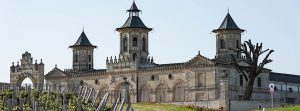Wine Score
Grape Variety
Bordeaux Blend
A Bordeaux Blend is a blended red wine that contains only those varieties that are authorized for use in the red wines of the Bordeaux region of France. Bordeaux is the most famous and highly coveted wine blend in the world. Like many wines with a long history, there’s a lot to learn, so we’re here to just cover the basics.
- Red Bordeaux blend is primarily composed of Cabernet Sauvignon, Merlot, and Cabernet Franc, with smaller portions of Malbec and Petit Verdot.
- White Bordeaux blend is primarily made of Sauvignon Blanc and Sémillon, with a splash of Muscadelle in the mix
While there are both red and white Bordeauxs, the name Bordeaux is primarily associated with the red wine blend. Red Bordeaux is a red wine that is always made from blending Cabernet Sauvignon wine and Merlot wine together, though the proportion of each depends on the location of the winery that made the wine.
- Left bank blends : tend to be higher in tannins, alcohol and acidity. They are powerful, rich wines that are said to age a bit better than wines from the Right Bank.
- Right bank blends : tend to be softer, less tannic and lower in alcohol and acidity. Because Merlot is the dominant grape, they are much more juicy and usually ready to be drunk much earlier than Left Bank Bordeauxs, and they’re often less expensive.
Haut Medoc Wine
 Haut-Médoc is the large southern section of the greater Médoc district of Bordeaux in southwestern France. It accounts for two-thirds of the Médoc peninsula.
Haut-Médoc is the large southern section of the greater Médoc district of Bordeaux in southwestern France. It accounts for two-thirds of the Médoc peninsula.
The appellation of the same name covers red wines produced within the same zone, but outside of the six communes which have their own AOP. Cabernet Sauvignon and Merlot are the main grape varieties. White wines made in Haut-Médoc AOP vineyards are bottled as Bordeaux Blanc.
The Haut-Médoc zone is home to the “famous four” appellations of Margaux, Pauillac, Saint-Estèphe and Saint-Julien, as well as the less famous Listrac and Moulis. These actually account for the majority of the wines produced within the Haut-Médoc. The more general title is used for vineyards lying outside these communes.
The soil in the Haut-Médoc region is mainly composed of thick gravel layers that have been swept down river over time and now sit on a base of heavy clay. The warm, well-drained gravel terraces provide ideal growing conditions for the late-ripening Cabernet Sauvignon grapes.
Further inland, the soils turn to deep deposits of clay. The Merlot grape variety thrives in such places. In recent decades it has largely usurped Cabernet Sauvignon in these parts of the Médoc. Patches of limestone and sandier soils add diversity to the more widely spread gravels, which otherwise dominate the terroir.
Much of the peninsula is former swamp land reclaimed by Dutch engineers in the 1600s. This was largely prompted by foreign demand for wines from Graves to the south of Bordeaux city, and from Douro in Portugal.
At the northern and western extremes of the Médoc peninsula, wines are produced under the Médoc appellation. These are the most heavily dredged areas of former swamps with little or no gravel. Until the 1940s they were known as the Bas Médoc, as a clearer counterpoint to the Haut-Médoc, but this name was deemed unfairly negative.
Credit : https://www.wine-searcher.com/regions-haut-medoc







